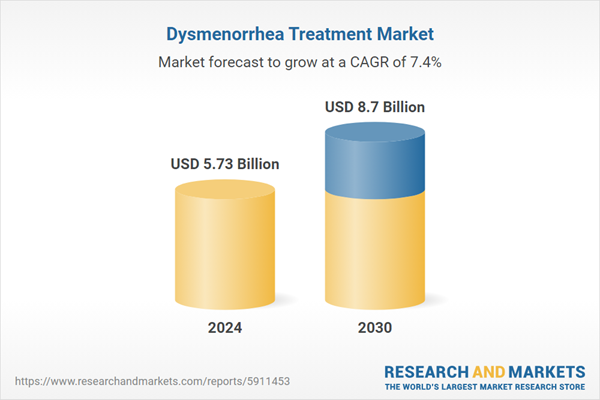Free Webex Call
Global Dysmenorrhea Treatment Market was valued at USD 5.73 million in 2024 and is anticipated to project impressive growth in the forecast period with a CAGR of 7.36% through 2030. Dysmenorrhea is a common gynecological condition characterized by severe menstrual pain and cramps experienced by many women during their menstrual cycle. The global dysmenorrhea treatment market refers to pharmaceutical and healthcare products and services aimed at addressing and alleviating the symptoms of dysmenorrhea. The global dysmenorrhea treatment market is driven by several key factors. The rising prevalence of menstrual disorders, particularly dysmenorrhea, among women worldwide is a major growth driver. Speak directly to the analyst to clarify any post sales queries you may have.
10% Free customizationThis report comes with 10% free customization, enabling you to add data that meets your specific business needs.
Increased awareness about menstrual health and growing healthcare expenditures have led to higher demand for effective treatment options, including pain relievers, hormonal therapies, and alternative medicine. Advances in pharmaceutical research and the development of novel nonsteroidal anti-inflammatory drugs (NSAIDs) and hormonal contraceptives further boost market expansion.
Additionally, the increasing adoption of telemedicine and e-pharmacies facilitates easier access to treatment solutions. Government initiatives promoting women’s health, coupled with growing support from non-profit organizations, contribute to market growth. The rising preference for natural and herbal remedies also drives innovation in dysmenorrhea treatment products. Moreover, a shift towards personalized medicine and the expansion of healthcare infrastructure in emerging economies present lucrative opportunities for market players, fostering overall market growth.
Key Market Drivers
Growing Female Population
The global dysmenorrhea treatment market has been on a steady rise, and one of the key factors driving its growth is the continuously expanding female population. Dysmenorrhea, commonly known as menstrual cramps, affects women of all ages, and as the global female population increases, so does the potential demand for effective treatments. For instance, a March 2022 study published in BMC Women's Health found that 92.3% (1,107 women) experienced primary dysmenorrhea (non-pathological), while 7.7% (92 women) had secondary dysmenorrhea (pathological). These findings highlight the high prevalence of menstrual pain among women, emphasizing the need for better management strategies and awareness of underlying conditions causing secondary dysmenorrhea.Dysmenorrhea is a prevalent gynecological condition characterized by severe menstrual pain and cramps. It affects women during their reproductive years, and as the female population grows, so does the number of individuals at risk of experiencing dysmenorrhea. This increased prevalence directly correlates with a higher demand for dysmenorrhea treatment options.
Key Market Challenges
Stigma and Taboos
One of the primary challenges in addressing dysmenorrhea is the persistence of stigma and cultural taboos surrounding menstruation. In many societies, menstruation remains a taboo subject, making it difficult for women to openly discuss their symptoms and seek appropriate treatment. This cultural barrier can deter women from seeking medical help and contribute to delayed diagnosis and treatment.Key Market Trends
Non-Pharmacological Approaches
While pharmaceuticals have traditionally been the go-to treatment for dysmenorrhea, there is a growing interest in non-pharmacological approaches. These include physical therapies, such as yoga and acupuncture, dietary modifications, and lifestyle changes. As women seek holistic and natural solutions, these alternative therapies are likely to gain prominence.Key Market Players
- Novartis AG
- Bayer AG
- Abbott Laboratories Inc.
- F Hoffmann-La Roche AG
- Sanofi SA
- Pfizer Inc.
- GSK PLC
- Johnson & Johnson
- Alvogen Inc.
- AbbVie Inc.
Report Scope:
In this report, the Global Dysmenorrhea Treatment Market has been segmented into the following categories, in addition to the industry trends which have also been detailed below:Dysmenorrhea Treatment Market, By Type:
- Primary Dysmenorrhea
- Secondary Dysmenorrhea
Dysmenorrhea Treatment Market, By Treatment:
- Medication
- Surgery
- Therapy
Dysmenorrhea Treatment Market, By End-Users:
- Hospitals & Clinics
- Ambulatory Care Centers
- Others
Dysmenorrhea Treatment Market, By Region:
- North America
- United States
- Canada
- Mexico
- Europe
- Germany
- United Kingdom
- France
- Italy
- Spain
- Asia-Pacific
- China
- Japan
- India
- Australia
- South Korea
- South America
- Brazil
- Argentina
- Colombia
- Middle East & Africa
- South Africa
- Saudi Arabia
- UAE
- Kuwait
Competitive Landscape
Company Profiles: Detailed analysis of the major companies present in the Global Dysmenorrhea Treatment Market.Available Customizations:
With the given market data, the publisher offers customizations according to a company's specific needs. The following customization options are available for the report.Company Information
- Detailed analysis and profiling of additional market players (up to five).
This product will be delivered within 1-3 business days.
Table of Contents
1. Product Overview
2. Research Methodology
3. Executive Summary
5. Global Dysmenorrhea Treatment Market Outlook
6. North America Dysmenorrhea Treatment Market Outlook
7. Europe Dysmenorrhea Treatment Market Outlook
8. Asia-Pacific Dysmenorrhea Treatment Market Outlook
9. South America Dysmenorrhea Treatment Market Outlook
10. Middle East and Africa Dysmenorrhea Treatment Market Outlook
11. Market Dynamics
12. Market Trends & Developments
13. Porter’s Five Forces Analysis
14. Competitive Landscape
Companies Mentioned
- Novartis AG
- Bayer AG
- Abbott Laboratories Inc.
- F Hoffmann-La Roche AG
- Sanofi SA
- Pfizer Inc.
- GSK PLC
- Johnson & Johnson
- Alvogen Inc.
- AbbVie Inc
Table Information
| Report Attribute | Details |
|---|---|
| No. of Pages | 186 |
| Published | March 2025 |
| Forecast Period | 2024 - 2030 |
| Estimated Market Value ( USD | $ 5.73 Billion |
| Forecasted Market Value ( USD | $ 8.7 Billion |
| Compound Annual Growth Rate | 7.3% |
| Regions Covered | Global |
| No. of Companies Mentioned | 10 |









